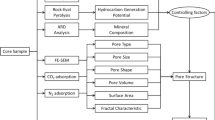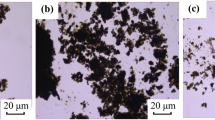Abstract
Deep shale gas reservoirs commonly contain connate water, which affects the enrichment and migration of shale gas and has attracted the attention of many scholars. It is significant to quantitatively estimate the amounts of adsorbed and free water in shale matrix pores, considering the different impacts of pore water (adsorbed water and free water) on shale gas. In this paper, pore water in six deep shale samples from the Wufeng-Longmaxi Formations in the Luzhou area, southern Sichuan Basin, China, was quantitatively evaluated by saturation-centrifugation experiments. Further, the impact of shale material composition and microstructure on the pore water occurrence was analyzed. The results show that amounts of adsorbed and free water are respectively 1.7967–9.8218 mg/g (mean 6.4501 mg/g) and 9.5511–19.802 mg/g (mean 13.9541 mg/g) under the experimental conditions (30°C, distilled water). The ratio of adsorbed water to total water is 15.83%–42.61% (mean 30.45%). The amounts of adsorbed and free water are related to the pore microstructure and material compositions of shale. The specific surface area of shale controls the amount of adsorbed water, and the pore volume controls the amount of free water; organic pores developed in shale solid asphalt contribute specific surface area and pore volume, and inorganic pores developed in clay mineral contribute pore volume. Therefore, the pores of shale solid asphalt accumulate the adsorbed water and free water, and the pores of clay minerals mainly accumulate the free water.
Similar content being viewed by others
References
Ahmad M, Haghighi M (2013). Water Saturation Evaluation of Murteree and Roseneath Shale Gas Reservoirs, Cooper Basin, Australia Using Wire-line Logs. Focused Ion Beam Milling and Scanning Electron Microscopy
Berner R A (1984). Sedimentary pyrite formation: an update. Geochim Cosmochim Acta, 48(4): 605–615
Chalmers G R L, Bustin R M (2007). The organic matter distribution and methane capacity of the lower Cretaceous strata of northeastern British Columbia, Canada. Int J Coal Geol, 70(1–3): 223–239
Chen X, Chen L, Tan X, Jiang S, Wang C (2021). Impact of pyrite on shale gas enrichment—a case study of the lower Silurian Longmaxi Formation in southeast Sichuan Basin. Front Earth Sci, 15(2): 332–342
Cheng P, Tian H, Xiao X, Gai H, Li T, Wang X (2017). Water distribution in overmature organic-rich shales: implications from water adsorption experiments. Energy Fuels, 31(12): 13120–13132
Dehghanpour H, Lan Q, Saeed Y, Fei H, Qi Z (2013). Spontaneous imbibition of brine and oil in gas shales: effect of water adsorption and resulting microfractures. Energy Fuels, 27(6): 3039–3049
Dong D, Shi Z, Guan Q, Jiang S, Zhang M, Zhang C, Wang S, Sun S, Yu R, Liu D, Peng P, Wang S (2018). Progress, challenges and prospects of shale gas exploration in the Wufeng–Longmaxi reservoirs in the Sichuan Basin. Natural Gas Industry B, 5(5): 415–424
Fang C, Huang Z, Wang Q, Zheng D, Liu H (2014). Cause and significance of the ultra-low water saturation in gas-enriched shale reservoir. Nat Gas Geosci, 25(3): 471–476
Gasparik M, Bertier P, Gensterblum Y, Ghanizadeh A, Krooss B M, Littke R (2014). Geological controls on the methane storage capacity in organic-rich shales. Int J Coal Geol, 123: 34–51
Guo X, Hu D, Li Y, Wei Z, Wei X, Liu Z (2017). Geological factors controlling shale gas enrichment and high production in Fuling shale gas field. Pet Explor Dev, 44(4): 513–523
Hao F, Zou H, Lu Y (2013). Mechanisms of shale gas storage: implications for shale gas exploration in China. AAPG Bull, 97(8): 1325–1346
Hu Y, Devegowda D, Striolo A, Van Phan A T, Ho T A, Civan F, Sigal R (2015). Microscopic dynamics of water and hydrocarbon in shale-kerogen pores of potentially mixed wettability. SPE J, 20(01): 112–124
Jiang L, Sun H, Yang S, Zhang Y, Xu H (2020). Investigation on multi-scale pore seepage model of shale gas reservoir considering diffusion and slippage effect. Microfluid Nanofluidics, 24(11): 83
Jiang T, Bian X, Wang H, Li S, Jia C, Liu H, Sun H (2017). Volume fracturing of deep shale gas horizontal wells. Nat Gas Ind B, 4(2): 127–133
Jiao F (2019). Theoretical insights, core technologies and practices concerning “volume development” of shale gas in China. Nat Gas Ind B, 6(6): 525–538
Jin Z, Nie H, Liu Q, Zhao J, Jiang T (2018). Source and seal coupling mechanism for shale gas enrichment in upper Ordovician Wufeng Formation–lower Silurian Longmaxi Formation in Sichuan Basin and its periphery. Mar Pet Geol, 97: 78–93
Larsen J W, Aida M T (2004). Kerogen chemistry 1. Sorption of water by Type II kerogens at room temperature. Energy Fuels, 18(5): 1603–1604
Li J, Li X, Wang X, Li Y, Wu K, Shi J, Yang L, Feng D, Zhang T, Yu P (2016). Water distribution characteristic and effect on methane adsorption capacity in shale clay. Int J Coal Geol, 159: 135–154
Li J, Li X, Wu K, Feng D, Zhang T, Zhang Y (2017a). Thickness and stability of water film confined inside nanoslits and nanocapillaries of shale and clay. Int J Coal Geol, 179: 253–268
Li J, Lu S, Cai J, Zhang P, Xue H, Zhao X (2018). Adsorbed and free oil in lacustrine nanoporous shale: a theoretical model and a case study. Energy Fuels, 32(12): 12247–12258
Li J, Lu S, Xie L, Zhang J, Xue H, Zhang P, Tian S (2017b). Modeling of hydrocarbon adsorption on continental oil shale: a case study on n-alkane. Fuel, 206: 603–613
Li J, Wang S, Lu S, Zhang P, Cai J, Zhao J, Li W (2019a). Microdistribution and mobility of water in gas shale: a theoretical and experimental study. Mar Pet Geol, 102: 496–507
Li R, Wu K, Li J, Xu J, Chen Z (2019b). Shale gas transport in wedged nanopores with water films. J Nat Gas Sci Eng, 66: 217–232
Liang C, Jiang Z, Zhang C, Guo L, Yang Y, Li J (2014). The shale characteristics and shale gas exploration prospects of the lower Silurian Longmaxi Shale, Sichuan Basin, south China. J Nat Gas Sci Eng, 21: 636–648
Long S, Feng D, Li F, Du W (2018). Prospect analysis of the deep marine shale gas exploration and development in the Sichuan Basin, China. J Nat Gas Geosci, 3(4): 181–189
Loucks R G, Reed R M, Ruppel S C, Jarvie D M (2009). Morphology, genesis, and distribution of nanometer-scale pores in siliceous mudstones of the Mississippian Barnett Shale. J Sediment Res, 79(12): 848–861
Ma X, Li X, Liang F, Wan Y, Shi Q, Wang Y, Zhang X, Che M, Guo W, Guo W (2020). Dominating factors on well productivity and development strategies optimization in Weiyuan shale gas play, Sichuan Basin, SW China. Pet Explor Dev, 47(3): 594–602
Odusina E, Sondergeld C, Rai C (2011). An NMR study on shale wettability. SPE: Calgary, Alberta, Canada; SPE-147371-MS
Pan Z, Connell L D, Camilleri M, Connelly L (2010). Effects of matrix moisture on gas diffusion and flow in coal. Fuel, 89(11): 3207–3217
Ross D J K, Marc Bustin R (2009). The importance of shale composition and pore structure upon gas storage potential of shale Gas Reservoirs. Mar Pet Geol, 26(6): 916–927
Sang G, Liu S, Elsworth D, Yang Y, Fan L (2020). Evaluation and modeling of water vapor sorption and transport in nanoporous shale. Int J Coal Geol, 228: 103553
Sang G, Liu S, Zhang R, Elsworth D, He L (2018). Nanopore characterization of mine roof shales by SANS, nitrogen adsorption, and mercury intrusion: impact on water adsorption/retention behavior. Int J Coal Geol, 200: 173–185
Sheng G, Su Y, Zhao H, Liu J (2020). A unified apparent porosity/permeability model of organic porous media: coupling complex pore structure and multi-migration mechanism. Adv Geo-Energy Res, 4(2): 115–125
Tang X, Ripepi N, Valentine K A, Keles C, Long T, Gonciaruk A (2017). Water vapor sorption on Marcellus shale: measurement, modeling and thermodynamic analysis. Fuel, 209(1): 606–614
Tian H, Wang M, Liu S, Zhang S, Zou C (2020). Influence of pore water on the gas storage of organic-rich shale. Energy Fuels, 34(5): 5293–5306
Wang P, Li X (2006). Thermal-weightlessness method to determine water content and existing form of hydratable clay. Nat Gas Ind, 26(1): 80–83
Wang T, Tian S, Li G, Sheng M, Ren W, Liu Q, Tan Y, Zhang P (2019). Experimental study of water vapor adsorption behaviors on shale. Fuel, 248: 168–177
Wu K, Chen Z, Li X, Guo C, Wei M (2016). A Model for multiple transport mechanisms through nanopores of shale gas reservoirs with real gas effect-adsorption-mechanic coupling. Int J Heat Mass Transf, 93: 408–426
Wu Q, Bai B, Ma Y, Ok J T, Neeves K B, Yin X (2014). Optic imaging of two-phase-flow behavior in 1D nanoscale channels. SPE J, 19(5): 793–802
Xie L, Lu S, Li J, Hu Y, Zhang P, Chen J, Zhang P (2015). Experimental investigations of the mineral wettability in shale and its influence factors. Acta Geol Sin, 89(s1): 170–171
Xu L, Wei H, Chen L, Liu L, Jiang Z, Yang K, Li X (2022). Storing characteristics and main controlling factors of connate water in lower Paleozoic Shales in Southeast Chongqing, China. J Petrol Sci Eng, 215: 110543
Yang B, Kang Y, You L, Li X, Chen Q (2016). Measurement of the surface diffusion coefficient for adsorbed gas in the fine mesopores and micropores of shale organic matter. Fuel, 181: 793–804
Yang R, Jia A, He S, Hu Q, Sun M, Dong T, Hou Y, Zhou S (2021). Experimental investigation of water vapor adsorption isotherm on gas-producing Longmaxi Shale: mathematical modeling and implication for water distribution in shale reservoirs. Chem Eng J, 406: 125982
Yang R, Jia A, Hu Q, Guo X, Sun M (2020). Particle size effect on water vapor sorption measurement of organic shale: one example from Dongyuemiao Member of lower Jurassic Ziliujing Formation in Jiannan area of China. Adv Geo-Energy Res, 4(2): 207–218
Yi J, Bao H, Zheng A, Zhang B, Shu Z, Li J, Wang C (2019). Main factors controlling marine shale gas enrichment and high-yield wells in South China: a case study of the Fuling shale gas field. Mar Pet Geol, 103: 114–125
Yuan W, Pan Z, Li X, Yang Y, Zhao C, Connell L D, Li S, He J (2014). Experimental study and modelling of methane adsorption and diffusion in shale. Fuel, 117: 509–519
Yuan Y, Rezaee R, Verrall M, Hu S Y, Zou J, Testmanti N (2018). Pore characterization and clay bound water assessment in shale with a combination of NMR and low-pressure nitrogen gas adsorption. Int J Coal Geol, 194: 11–21
Zhang J, Shi M, Wang D, Tong Z, Hou X, Niu J, Li X, Li Z, Zhang P, Huang Y (2022). Fields and directions for shale gas exploration in China. Nat Gas Ind B, 9(1): 20–32
Zhang T, Li X, Sun Z, Feng D, Miao Y, Li P, Zhang Z (2017). An analytical model for relative permeability in water-wet nanoporous media. Chem Eng Sci, 174: 1–12
Zhu Y, Chen G, Liu Y, Shi X, Wu W, Luo C, Yang X, Yang Y, Zou Y (2021). Sequence stratigraphy and lithofacies paleogeographic evolution of Katian Stage–Aeronian Stage in southern Sichuan Basin, SW China. Pet Explor Dev, 48(5): 1126–1138
Zou C, Dong D, Wang Y, Li X, Huang J, Wang S, Guan Q, Zhang C, Wang H, Liu H, Bai W, Liang F, Lin W, Zhao Q, Liu D, Yang Z, Liang P, Sun S, Qiu Z (2016). Shale gas in China: characteristics, challenges and prospects (II). Pet Explor Dev, 43(2): 182–196
Acknowledgments
This work was supported by the National Natural Science Foundation of China (Grant No. 41972123).
Author information
Authors and Affiliations
Corresponding authors
Ethics declarations
Competing interests The authors declare that they have no competing interests.
Rights and permissions
About this article
Cite this article
Zhao, S., Liu, Y., Lu, S. et al. Quantitative evaluation of adsorbed and free water in deep shales: a case study on the Wufeng-Longmaxi Formations from the Luzhou area, southern Sichuan Basin, China. Front. Earth Sci. (2024). https://doi.org/10.1007/s11707-022-1056-4
Received:
Accepted:
Published:
DOI: https://doi.org/10.1007/s11707-022-1056-4




